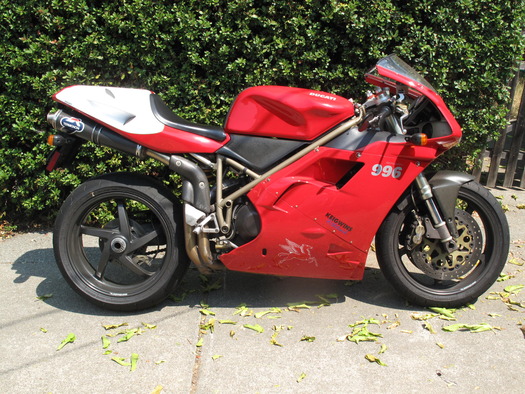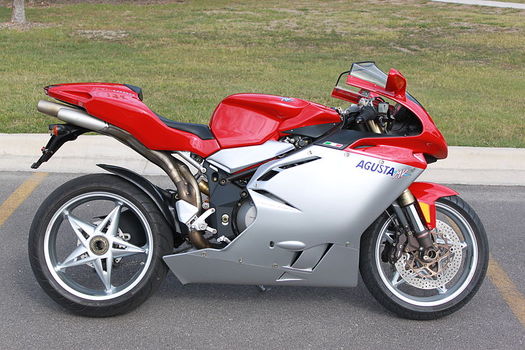
Massimo Tamburini's masterful Ducati 996sps, momentarily at rest in California. Photo by Owen Edwards
In the diverse clan of industrial designers, most of the glamour adheres to furniture folk such as George Nelson and the Eameses. Following close behind, on four stylish wheels, are car designers, from Raymond Loewy with Studebaker and Harley Earl with General Motors to Chris Bangle at BMW and J Mays at Ford. Sad, for some of us, is the fact that given the far smaller demand for two-wheelers, those who design motorcycles tend to sit below the salt, down with the B-listers. (Of course, so did Mozart, but that’s another story.)
In part, this is because the Japanese dominate the market, and companies such as Honda and Yamaha tend to design motorcycles — remarkable motorcycles — by committee. Harley Davidson does have a renowned designer, Willie G. Davidson — grandson of the co-founder — who has had a hand and eye in producing most of the ever-popular hogs for decades. But the recent death of Italy’s Massimo Tamburini, at 70, from lung cancer, brought to an end the glittering career of perhaps the greatest motorcycle designer ever, but also — in my opinion — one of the greatest industrial designers of recent decades.
Tamburini was born in 1943 in Rimini, Italy. He has recalled in interviews that as a small boy he tormented his mother with an all-encompassing passion for motorcycles, which she described as an obsession. Despite the very real possibility that he could have worked for Ghia or Pininfarina or any other of the great European coachwork designers — or for that matter could have done wonders with furniture, toasters, or even flatware (see: Massimo Vignelli), he wanted to design motorcycles, and that was all he did. And all he did with his work was change forever what motorcycles look like. The headline on The New York Times obituary called him a “motorcycle artisan,” but a far more appropriate word would have been “artist.”
In his hometown, Tamburini ran a heating and air conditioning business, but his fascination with motorcycles gained him a reputation as a go-to guy for race tuning, someone who could make bikes hotter as well as houses cooler. As a young, self-taught ingeniere, (no Art Center for him) Tamburini helped found a company called Bimota — Bi for Valerio Bianchi, Mo for Giuseppe Morri, Ta for Tamburini — that put the engines of other manufactures into sleek plastic shells and well-engineered frames and suspensions. Tamburini’s skills as a sculptor in the great tradition of the Italian Renaissance were evident in the shapes of Bimotas, along with his ability to combine the practical need to reduce wind resistance and alluring aesthetics. Track successes for Bimotas led to his signing on with Cagiva and a lifelong friendship with that company’s visionary boss Claudio Castiglioni. When Castiglioni bought Ducati, Tamburini began the fast climb to the zenith of his career, producing motorcycles that were very fast works of art.

MV Agusta F4. Photo by MVParker
His first Ducati, in 1986, was the Paso, a 750 cubic centimeter machine named for the late racer Renzo Pasolini, for which he designed a fully enclosed fairing, a race-inspired approach that Honda had already tried with the VF100, but that Tamburini sculpted to perfection. Shaped for the wind, the bike — and subsequent Tamburini Ducatis — looked shaped by the wind. The Paso introduced to motorcycles the sensuous looks of Ferraris and Alfa Romeos that typified Italian car design. Tamburini’s magnum opus for Ducati was the 916 (the number indicating the twin cylinder engine’s displacement), a bike that had motorcyclists salivating and then eagerly writing checks. When Cagiva sold Ducati to an American private equity firm, Tamburini chose to stay with the Italian company. At Cagiva he then designed the MV Augusta F4, a continuation and perfection of the 916 style that many bike connoisseurs — including me — consider the most beautiful motorcycle ever to touch asphalt. It was no coincidence that at the wildly popular Art of the Motorcycle exhibition at the Guggenheim in 1998, the first bike one saw emerging from the elevator (to walk down the museum’s ramps as the show’s curators intended) was the Ducati 916, and the last machine one saw at the end of the lineup of more than one hundred bikes was the MV Augusta F4. The exhibition was a salute to motorcycle makers through time, and nothing could have been more appropriate than to give Tamburini those memorable bookends.
I’ve had the great pleasure of owning and riding a quartet of Tamburini motorbikes, starting with a Paso and moving on to a 900sp, a 748 (a smaller displacement version of the 916), and the 996, a 916 look-alike with a larger motor that stands in my garage now. And I can say, with considerable personal bias, that all those bikes have passed the classic design test: Every time I get off one and walk away, I take a long look back to remind myself how lucky I am. Grazie, Signore Tamburini.
